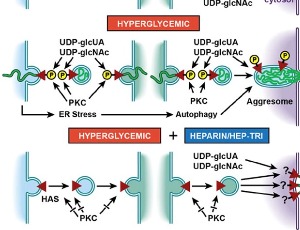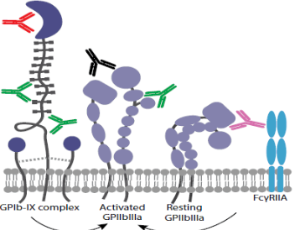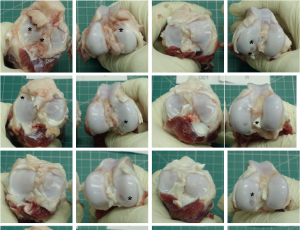Loading
Journal of Cellular Immunology
ISSN: 2689-2812
Editors Choice Articles
A Review of the Possibility of Nafamostat Mesylate in COVID-19 Treatment
Ji-Young Rhee
Nafamostat mesylate is a synthetic serine protease inhibitor, which inhibits various enzyme systems such as coagulation and fibrinolytic systems, the kallikrein–kinin system, the complement system, and the activation of protease-activated receptors. It also inhibits lipopolysaccharide-induced nitric oxide production, apoptosis, and interleukin (IL)-6 and IL-8 levels in cultured human trophoblasts.
J Cell Immunol, 2021, Volume 3, Issue 1, p1-7 | DOI: 10.33696/immunology.3.069
Intracellular Hyaluronan Synthesis Impairs Hematopoiesis in Diabetes that can be Prevented by Heparin
Andrew Jun Wang, Vincent Charles Hascall
Hyperglycemia in diabetes induces impairment of hematopoiesis, an important consequence in bone marrow (BM) that contributes to chronic complications in advanced diabetes. The alterations to blood cells associated with diabetes mellitus (DM) pathologies have been carefully and extensively documented, but the underlying mechanism(s) is still unclear. Our recent publication indicates that aberrant intracellular synthesis of hyaluronan (HA) by hyperglycemic dividing BM progenitors is the central mechanism involved.
J Cell Immunol, 2023, Volume 5, Issue 1, p1-6 | DOI: 10.33696/immunology.5.155
Is Platelet Desialylation a Novel Biomarker and Therapeutic Target in Immune Thrombocytopenia?
June Li, Jade A. Sullivan, Heyu Ni
Immune thrombocytopenia is an autoimmune disease predominantly caused by autoantibody mediated platelet and megakaryocyte destruction and or dysfunction, which leads to low platelet counts and risk of bleeding. Currently prognostic biomarkers are underdeveloped and there lacks a gold-standard for therapeutics, which leaves an inexplicable refractory subset of patients which are clinically challenging.
J Cell Immunol, 2020, Volume 2, Issue 1, p6-14 | DOI: 10.33696/immunology.2.012
Tenofovir at the Crossroad of the Therapy and Prophylaxis of HIV and HBV Infections
Erik De Clercq
Tenofovir, alias (R)-PMPA, was first divulged as an anti- HIV agent in 1993 [1]. That it would in 2012, become the first antiretroviral agent, approved by the US FDA (Food and Drug Administration) to prevent HIV infection, could have been predicted from the findings of Tsai et al.
J Cell Immunol, 2020, Volume 2, Issue 1, p23-30 | DOI: 10.33696/immunology.2.015
Essentials of CAR-T Therapy and Associated Microbial Challenges in Long Run Immunotherapy
Muhammad Kalim, Rui Jing, Xin Li, Zhiwu Jiang, Ningbo Zheng, Ziyu Wang, Guo Wei, Yong Lu
Chimeric antigen receptor (CAR)-T cell therapy has shown potential in improving outcomes for individuals with hematological malignancies. However, achieving long-term full remission for blood cancer remains challenging due to severe life-threatening toxicities such as limited anti-tumor efficacy, antigen escape, trafficking restrictions, and limited tumor invasion. Furthermore, the interactions between CAR-T cells and their host tumor microenvironments have a significant impact on CAR-T function.
J Cell Immunol, 2024, Volume 6, Issue 1, p25-50 | DOI: 10.33696/immunology.6.189
The Natural History of Post-Chikungunya Viral Arthritis Disease Activity and T-cell Immunology: A Cohort Study
Aileen Yu-hen Chang, Alfonso Sucerquia Hernández, Jose Forero-Mejía, Sarah Renee Tritsch, Evelyn Mendoza-Torres, Liliana Encinales, Andres Cadena Bonfanti, Abigale Marie Proctor, Gary Leonard Simon, Samuel Joseph Simmens, Gary Steven Firestein
Background: Chikungunya virus (CHIKV) is an alphavirus spread by mosquitos that causes arthralgias and arthritis that may last for years. The objective of this study was to describe the arthritis progression and T cell immunology over a two-year period. Methods: A cohort of 40 cases of serologically confirmed CHIKV from Magdalena and Atlántico, Colombia were followed in 2019 and again in 2021. Arthritis disease severity, disability, pain, stiffness, physical function, mobility, fatigue, anxiety, sleep disturbances and depression were assessed.
J Cell Immunol, 2024, Volume 6, Issue 2, p64-75 | DOI: 10.33696/immunology.6.191
Inflammatory, Functional, and Compositional Changes of the Uterine Immune Microenvironment in a Lymphangioleiomyomatosis Mouse Model
Danielle S. Stiene, Andrew R. Osterburg, Lori B. Corsarie, Nick R. Balzarini, Mario Medvedovic, Michael T. Borchers
Lymphangioleiomyomatosis (LAM) is a rare, female-dominated pulmonary cystic disease. Cysts that develop in LAM are characterized by the presence of smooth muscle-like (LAMCore) cells in the periphery. These cells harbor mutations in Tuberous Sclerosis Complex 1 or 2 (TSC1/2), driving uncontrolled proliferation through the mTORC1 pathway. LAMCore cells originate from an extrapulmonary source. Published data supports the uterine origin of LAMCore cells that metastasize from the uterus to precipitate pulmonary function destruction. Immune evasion is hypothesized to occur to allow seeding of the lungs from the uterus. This evasion specifically involves dysfunctional NK cells to allow aberrant proliferation and migration from the tissue.
J Cell Immunol, 2025, Volume 7, Issue 3, p74-97 | DOI: 10.33696/immunology.7.227
Advances of Immune Cells in the Pathogenesis and Targeted Therapy of Systemic Lupus Erythematosus
Junyue Fang, Li Lin, Xiaoyun Xiao, Jingwei Tian, Meng Zhang, Phei Er Saw
Systemic lupus erythematosus (SLE) is a heterogeneous autoimmune disease reflecting an imbalance between regulatory and effector immune responses. With the rapid development of molecular biology and multi-omics, the pathogenesis of SLE has been gradually elucidated. In particular, imbalances and abnormalities in immune cell function have been shown to play an important role in the development of SLE. Understanding the specific pathogenesis of SLE is the basis for targeted therapy against specific targets.
J Cell Immunol, 2024, Volume 6, Issue 2, p98-112 | DOI: 10.33696/immunology.6.195
M1 and M2 Macrophages Polarization via mTORC1 Influences Innate Immunity and Outcome of Ehrlichia Infection
Ibrahim Ahmed, Nahed Ismail
Human monocytic ehrlichiosis (HME) is an emerging life-threatening tick-borne disease caused by the obligate intracellular bacterium Ehrlichia chaffeensis. HME is often presented as a nonspecific flu-like illness characterized by presence of fever, headache, malaise, and myalgia. However, in some cases the disease can evolve to a severe form, which is commonly marked by acute liver injury followed by multi-organ failure and toxic shock-like syndrome.
J Cell Immunol, 2020, Volume 2, Issue 3, p108-115 | DOI: 10.33696/immunology.2.029
Microbial Resistance to Photodynamic Therapy
Alison M Mackay
Microbial resistance to antibiotics has become a major area of research having caused over a million human deaths in 2019. At present, lower respiratory infection is the most burdensome disease. Antimicrobial Photodynamic Therapy (PDT) is regularly reported not to cause resistance in any pathogen, and to eradicate both microbes that are susceptible to antibiotics and those that are resistant.
J Cell Immunol, 2022, Volume 4, Issue 3, p117-120 | DOI: 10.33696/immunology.4.139
Sialyllactose Prevents Cartilage Damages via M0 Macrophage Maintenance in Yucatan Mini-Pig Osteoarthritis Model
Kyung-Tai Kim, Young-Kyu Kim, Mi-Jin Yang, Min-Young Kim, Lila Kim, Jeong Ho Hwang
Sialyllactose, known to be abundant in human breast milk, has anti-inflammatory properties, but its preventive effect on osteoarthritis remain unclear. Here, we demonstrated the efficacy of 3’ sialyllactose (3’ SL) and 6’ sialyllactose (6’ SL) in preventing osteoarthritis in Yucatan mini-pigs. Twelve female Yucatan mini-pigs were administered 0, 200, 400 mg 3’ SL or a combination of 200 mg 3’ SL + 200 mg 6’ SL for 12 weeks (4weeks before and 8 weeks after surgery); then, osteoarthritis was induced in the left knee by anterior cruciate ligament transection surgery.
J Cell Immunol, 2022, Volume 4, Issue 5, p158-166 | DOI: 10.33696/immunology.4.145
Establishment of an Indirect Enzyme-linked Immunosorbent Assay for Detection of the NS4 Protein of Bluetongue Virus
Ji Ma, Xianping Ma, Rang Wang, Fang Li, Tingjun Hu, Huashan Yi
An indirect enzyme-linked immunosorbent assay (iELISA) was established to detect the serological prevalence of bluetongue virus (BTV) infection in ruminant populations. A recombinant NS4 (rNS4) protein was used as the encapsulated antigen. Optimization of the iELISA included the encapsulated antigen, serum dilution, blocking solution, and working concentration of a horseradish peroxidase (HRP)-labeled secondary antibody (Ab) by the square-matrix titration test.
J Cell Immunol, 2022, Volume 4, Issue 5, p180-184 | DOI: 10.33696/immunology.4.148
Polyamines: Key Players in Immunometabolism and Immune Regulation
Shanmuga S. Mahalingam, Pushpa Pandiyan
Polyamines are small organic molecules ubiquitously present in all living organisms and function as crucial regulators of biological processes ranging from fundamental cellular metabolism to immune regulation. Dysregulation of polyamine metabolism has been implicated in numerous diseases, including neurodegenerative disorders, inflammatory conditions, autoimmune diseases, and cancer. This review provides an overview of pathophysiology of these conditions, highlighting polyamines’ role in immunometabolic alterations in the context of immune regulation.
J Cell Immunol, 2024, Volume 6, Issue 5, p196-208 | DOI: 10.33696/immunology.6.206
Updates of Recent Vinpocetine Research in Treating Cardiovascular Diseases
Chongyang Zhang, Chen Yan
Vinpocetine is a derivative of vincamine. It has been used to prevent and treat cerebrovascular disorders such as stoke and dementia, and remains widely available in dietary supplements that often marketed as nootropics. Due to its excellent safety profile at therapeutic dose regimen, vinpocetine has raised research interest in its new applications in various experimental disease models.
J Cell Immunol, 2020, Volume 2, Issue 5, p211-219 | DOI: 10.33696/immunology.2.045
Evaluating the Role of the Renin-angiotensin System in COVID-19: Implications for ACE Inhibitor and ARB Use During SARS-CoV-2 Infection
Sarah Renee Tritsch, Evelyn Mendoza-Torres, Mónica Gómez-Pulido, Jairo Castellar-López, Rebecca Lynch, Carlos Andres Herrera Gomez, Hana Akselrod, Adrienne Poon, Samuel Joseph Simmens, Christopher N. Mores, Gary Leonard Simon, Lauren C. Ray, Sarah Conway, Aileen Yu-hen Chang
This study aimed to investigate the role of the renin-angiotensin system (RAS) in COVID-19, particularly focusing on key components such as ACE, ACE2, and their related peptides, angiotensin-(1-7) and angiotensin-(1-9). Using serum samples from healthy controls and both non-severe and severe COVID-19 patients, ELISA assays revealed no significant differences in these RAS components between the groups.
J Cell Immunol, 2024, Volume 6, Issue 6, p255-265 | DOI: 10.33696/immunology.6.213
Human Gray and White Matter Metabolomics to Differentiate APOE and Stage Dependent Changes in Alzheimer’s Disease
Tyler C. Hammond, Xin Xing, Lucy M. Yanckello, Arnold Stromberg, Ya-Hsuan Chang, Peter T. Nelson, Ai-Ling Lin
Alzheimer’s disease (AD) is the most common form of dementia with hallmarks of ß-amyloid (Aß) plaques, tau tangles, and neurodegeneration. Studies have shown that neurodegeneration components, especially brain metabolic deficits, are more predictable for AD severity than Aß and tau. However, detailed knowledge of the biochemical composition of AD brain tissue vs. normal brain tissue remains unclear.
J Cell Immunol, 2021, Volume 3, Issue 6, p397-412 | DOI: 10.33696/immunology.3.123
About Scientific Archives
Scientific Archives is a global publisher initiated with the mission of ensuring equal opportunity for accessing science to research community all over the world. Spreading research findings with great relevance to all channels without any barrier is our goal. We want to overcome the challenges of Open Access with ensured quality and transparency.
